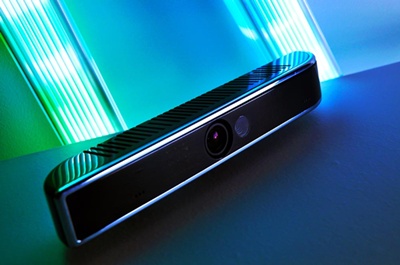12 Nov 2010
A revolution in user interaction with TVs, games consoles and computers is under way, as developers such as in3Depth Systems bring gesture control to the masses.
Innovative user interfaces can be a dramatic spur to the adoption of new devices, as the touch-screen controls of the iPhone ably demonstrated. In home entertainment the next revolution is all set to hinge on gesture control, allowing users to interact with games consoles or PCs without needing to touch a controller at all. This month's launch of Microsoft's Kinect system for the Xbox 360 console proves that gesture recognition is fast becoming ready for prime time.
As developers prepare to fight for a share of this market, Belgian group in3Depth Systems has secured an investment of €10 million in Series B venture finance from investors including European telecom operator Belgacom, to support further development of its gesture-controlled user interfaces and applications.

Making gesture control work effectively requires a marriage of sensor control, software development and precise user interface design. Belgian developers in all three areas have come together under the in3Depth umbrella.
At the heart of the system is ‘DepthSense’, a family of time-of-flight CMOS sensors. Developed by Optrima, a Brussels-based subsidiary of in3Depth, DepthSense is the fruit of eight years of research into time-of-flight sensors by the fabless semiconductor company.
Time-of-flight challenges
"In time-of-flight imaging systems, infrared light is pulsed towards the scene at a frequency of several megahertz," said Daniël Van Nieuwenhove, CTO of Optrima. "These pulses are reflected back, captured by the sensor and turned into a distance measurement by each of the several thousand DepthSense pixels in Optrima's CMOS imagers."
DepthSense is a proprietary native CMOS imager technology, providing a direct way to acquire 3D information about objects in view. It has been designed to be compatible with standard CMOS processing, allowing the integration of CMOS logic, memory and processing units to create monolithic system-on-chip (SoC) 3D time-of-flight imagers.
Not all gesture recognition systems operate in the same way, however. Microsoft's Kinect encodes information in the emitted IR radiation in the form of light patterns and then analyses the distortions in this pattern upon its return, while DepthSense relies on time-of-flight analysis. But whichever approach is employed, the complexity of the sensing process can be formidable, placing severe demands on the CMOS sensor at the heart of the operation.
Van Nieuwenhove lists the many challenges: "The amount of light present in the scene; optimization of the illumination allocated at the camera; a high frame rate; fast movement capture; low-noise operation; good resolution in x,y and z directions - not to mention the cost of the complete system - are just a few of the many parameters and properties that need to be resolved. DepthSense is the result of research focused on these issues, during which key components, such as an efficient and optimized pixel for time-of-flight and other advanced implementations, were invented and granted as international patents."
Benefits of CMOS
On a per-pixel basis, the performance of the sensor is determined by a further set of parameters, including the sensitivity of the sensor to infrared light, the fill factor, the pixel pitch, and efficiency in the time-of-flight operation itself. "DepthSense has been designed to have an advantageous impact on each of these parameters, which translates into a better pixel performance," Van Nieuwenhove said. "For example, DepthSense controls photo-generated charges even when they are generated deep in the substrate of the semiconductor. This is very valuable, since at the typical wavelength of 870 nm the photons penetrate deeply into the substrate. Taken overall, current DepthSense-based sensors provide a unique combination of low bill-of-materials costs and high 3D image quality."
One significant choice has been to focus on CMOS technology rather than the alternative. According to Van Nieuwenhove, 3D sensing using time-of-flight measurements has previously been implemented using CCD principles, while DepthSense employs techniques optimized for CMOS.
"There are only a handful of competitors worldwide in this sector, of which two, 3DV and Canesta, have been bought by Microsoft. Our CMOS technology is very different from that used by our competitors, who employ similar CCD-based principles. This translates into a number of advantages for DepthSense, including higher efficiency, improved sensitivity, and lower image lag, along with completely independent IP."
Belgian approach
The companies operating under the umbrella of in3Depth Systems demonstrate a strategic effort by Belgium's high technology sector to position itself for the growth in gesture-controlled applications.
Optrima was originally founded as a spin-off from the Electronics and Informatics department (ETRO) of Vrije Universiteit Brussel, focusing on the commercialization of the 3D technology developed within ETRO. "Optrima is now a wholly owned subsidiary of the in3Depth Systems holding company," commented André Miodezky, CEO of Optrima. "Other companies within in3Depth include Softkinetic, whose gesture recognition software allows developers to deploy gesture-based functionality accessible by all major 3D camera manufacturers. A separate unit, Softkinetic Studios, has developed a user interface applicable to end users in gaming, TV and other markets, enabling clients to use 3D gesture technologies off the shelf."
This concerted approach to tackling new application areas is characteristic of Belgium's photonics sector, where Virije Universiteit Brussel has acted as the hub for a number of successful spin-out and applied photonics companies.
About the Author
Tim Hayes is a freelance journalist based in Bristol, UK.
| © 2026 SPIE Europe |
|